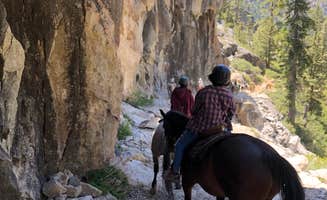Kennedy Meadows Campground serves as a basecamp for horseback riding excursions at 6,000 feet elevation with access to high-country trails. The campground connects to multiple backcountry routes, including the Pacific Crest Trail. Horse camping facilities accommodate trailers and riders seeking wilderness exploration, with natural water sources available from the nearby Kern River.
What to do
Trail riding access: The Whitney Portal area offers numerous riding trails with mountain views. "We explored this in completely unprepared clothing but it was so worth it. Camp spots are right in the middle of the forest, it feels like every campsite is it's own little mountain," explains C N. For multi-day rides, the trails connect to several wilderness destinations.
Alpine lake exploration: Horseshoe Meadow Campground provides direct trail access to mountain lakes. "Hikes nearby from beginner to expert take you to alpine lakes," notes Katie H. The campground has both day-use and overnight facilities for riders at approximately 10,000 feet elevation.
Meadow grazing opportunities: Flat meadow areas near the campgrounds support natural grazing during proper seasons. "Cast meadow to the west is wonderful for morning walk with coffee," reports Katie H. about Horseshoe Meadow. Riders should check with camp hosts about current grazing regulations, which may change seasonally.
What campers like
High-elevation riding: The Alabama Hills Dispersed Site provides free camping with views of the Sierra Nevada range. "This site is on Horseshoe Meadow Road about 1/2 mile north of the Tuttle Creek site. There are 3 legal spots with camping signs," notes Kent G. The area connects to mountain trails and desert terrain riding routes.
Wildlife viewing: Tuttle Creek Campground offers opportunities to view local wildlife. "Beautiful campground. We were in site 28. Clean pit toilets. Stunning views," reports Deb H. Horse riders frequently report seeing deer, coyotes, and occasionally bighorn sheep on higher-elevation trails.
River access for horses: Several campgrounds provide water access for horses from natural sources. "The fishing was awful, I'm sure the area is incredibly over-fished due to popularity. There was NO potable water so bring your own. There was river access if you choose to filter your own water," notes Erin M. about Kennedy Meadows.
What you should know
Seasonal limitations: Fossil Falls dry lake bed demonstrates typical seasonal variations. "All the space you'd want. All the service you need. Super accessible. Make sure your stuff is tied down tight. Upwards for 40mph thought my roof rack was a goner," warns Lincoln P. Mountain campgrounds generally operate June through October.
Water availability varies: Many campgrounds have reduced water service. "So I've camped there at least 25 times. A lot of there information here is no longer true. It does sit beside the lower fork of the Kern River. The forest service hasn't managed it in years the guy who owns the Kennedy Meadows store is in charge. There's been no faucet water there in over 5 years," reports Mike The Bike about Kennedy Meadows.
Manure management requirements: Equestrian campers must follow pack-in, pack-out practices. "The hike to Kennedy meadows campground was wonderful and scenic and the campground itself is in a nice location. The only downfall is the trail and campground is shared for horses and there is POOP EVERYWHERE," notes Sonia P. Riders should bring appropriate equipment for waste management.
Tips for camping with families
Space considerations: Lone Pine Campground accommodates families with adequate space for multiple tents. "Stayed here a few days before hiking Whitney. Great place to acclimate, second to Whitney portal campground. We camped at one of the walk-in sites. Enough space for the 4 of us, 2 tents, and the family pup," explains Vanessa H.
Kid-friendly areas: Some campgrounds offer natural play spaces for children. "The campground was nice, quiet. There was a nice stream you could fish with some trout. There are a couple big boulders the kids can climb on and around," shares Mark G. about Lone Pine Campground.
Temperature planning: Mountain weather changes rapidly, requiring preparation. "Obviously, it was very hot when we went at the end of June (80s-90s in the day and fairly cold at night). Depending on your individual campsite, there may not be a lot of shade available to you, so plan accordingly if you are going in the summer," advises Madeline B.
Tips from RVers
Levelness challenges: Equestrian sites often have uneven terrain. "Good for tent camping, but no pull-in or flat spots if you're sleeping in your vehicle. I slept in the equestrian campground since those were back-in sites, but if there are horses you're not allowed to do that," explains Kristian W. about Horseshoe Meadow.
Limited RV accommodations: Many equestrian campgrounds have minimal facilities for larger vehicles. "There are 2 sites with fire pits and covered picnic tables that could fit a large van at most. There is one other spot that is level but has no fire pit or covered table," notes Laura M. about Walker Pass Campground.
Dump station availability: When available, dump stations often close seasonally. "Labor day weekend and half the campground is closed, water faucets are locked, and dump station is closed. We specifically chose this campground for the convenience of water and dump station," reports K L. about Tuttle Creek.


